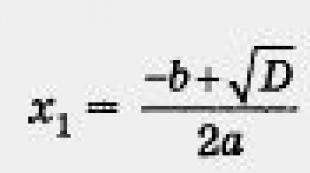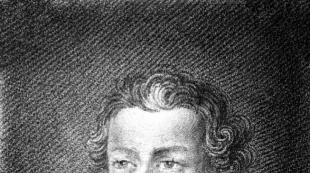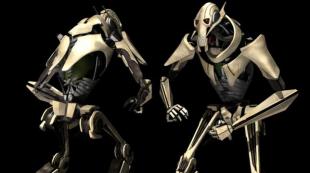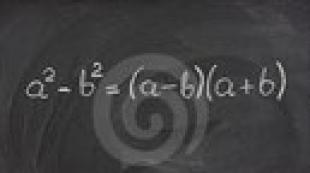Nod coprime numbers. “Greatest common divisor. Coprime numbers. The concept of pairwise primes
urban district of Tolyatti
“Greatest common divisor. Coprime numbers.
Teacher Kostina T.K.
g. o. Tolyatti
Presentation on theme: "Greatest Common Divisor.
Coprime Numbers"
Preliminary preparation for the lesson: students should know the following topics: "Divisors and multiples", "Signs of divisibility by 10, 5, 2, 3, 9", "Prime and composite numbers", "Decomposition into prime factors"
Lesson Objectives:
Educational: to study the concepts of GCD and relatively prime numbers; teach students to find GCD numbers; create conditions for developing the ability to summarize the studied material, analyze, compare and draw conclusions.
Educational: the formation of self-control skills; fostering a sense of responsibility.
Developing: development of memory, imagination, thinking, attention, ingenuity.
During the classes
Minutes of logical tasksOral work.
1. Grandparents brought an odd number of apricots from the garden for their two grandchildren. Can these apricots be divided equally among the grandchildren? [can]
2. From one village to another 3 km. Two people came out of these villages towards each other with the same speed. The meeting took place half an hour later. Find the speed of each.
3. The tourist has passed 2/5 of the whole way. After that, he had to go 4 km more than he did. Find all the way.
4. The number of eggs in the basket is less than 40. If they are counted in pairs, then 1 egg will remain. If you count them in triplets, then there will still be one egg each. How many eggs are in the basket? (31)
2. Repetition.
According to the table, we repeat the definition of a divisor, a multiple, signs of divisibility, the definition of prime and composite numbers. On the screen are slides depicting animals, a map of the Samara region, photographs of a VAZ.
3. Learning new material in the form of a conversation.
What are the divisors of the number 18, 21, 24.
The area of the VAZ is 500 hectares. Into what prime factors can this number be decomposed? 500=2*5*2*5*5=2 2 *5 3
What are the common divisors of the numbers 120 and 80.
The weight of the bear is 525 kg. The mass of an elephant is 5025 kg. Name some common divisors
The beaver weighs 24 kg and is 97 cm long. Which numbers are simple or complex? Name their common divisors.
56640 tons of oxygen is consumed by 1 passenger aircraft for 9 hours of operation. This amount of oxygen is released during photosynthesis of 35,000 hectares of forest. Name some divisors of this number.
Which of these numbers are prime and which are composite? 111, 313, 323, 437, 549, 677, 781, 891?
Which number is divisible by all numbers without a remainder?
What is the divisor of any natural number?
Is the expression 34*28+85*20 divisible by 17?
Is the expression 4132*7008 divisible by 3?
What is the quotient (3*5*2*7*13)/(5*2*13)=?
What is the product of (2*5*5*5*3)*(2*2*2*2*3)?
Name some prime numbers.
The further we go along the natural series of numbers, the more difficult it is to find prime numbers. Imagine that we are flying in an airplane that flies along a natural line. It's dark all around and only prime numbers are marked with lights. There are a lot of lights at the beginning of the journey, and then less and less.
The ancient Greek scientist Euclid proved 2300 years ago that there are infinitely many prime numbers and that there is no largest prime number.
The problem of prime numbers was studied by many mathematicians, including the ancient Greek scientist Eratosthenes. His method of finding prime numbers was called the sieve of Eratosthenes.
Goldbach and Euler, who lived in the 18th century and were members of the St. Petersburg Academy of Sciences, dealt with the problem of prime numbers. They assumed that every natural number can be represented as a sum of prime numbers, but this has not been proven. In 1937, the Soviet academician Vinogradov proved this proposition.
An Indian elephant lived for 65 years, a crocodile for 51 years, a camel for 23 years, and a horse for 19 years. Which of these numbers are prime and composite?
The wolf is chasing the hare, he needs to get through the labyrinth. You can pass if the answer is a prime number [mazes in the form of circles, on which there are three examples, and in the center there is a house]
1000-2; 250*2+9; 310/5
24/4, 2 2 +41, 23+140
10-3; 133+12; 28*5
To the task on the board record:
Divisors 48: 1, 2, 3, 4, 6, 8, 12, 16, 48
Divisors 36: 1, 2, 3, 4, 6, 12, 18, 36
GCD (48; 36) \u003d 12 12 gifts determination of the GCD of the divisor rule for finding the GCD
And how to find the GCD of large numbers, when it is difficult to list all the divisors. According to the table and the textbook, we derive the rule. We highlight the main words: decompose, compose, multiply.
I show examples of finding GCD from large numbers, here we can say that GCD of large numbers can be found using the Euclidean algorithm. We will get acquainted with this algorithm in detail in the classroom of the mathematical school.
An algorithm is a rule according to which actions are performed. In the 9th century, such rules were given by the Arab mathematician Alkhvaruimi.
4. Work in groups of 4 people.
Everyone gets one of 4 options for tasks, where the following is indicated:
The student must study the theory from the textbook and answer one question
Study an example of finding GCD
Complete tasks for independent work.
At the end of the work, a small independent work is carried out.
CSR cards
Option 1
1. What number is called prime? What is a composite number?
2. Find GCD (96; 36)
To find the GCD of numbers, you need to decompose the given numbers into prime factors.
| 96 | 2 |
| 48 | 2 |
| 24 | 2 |
| 12 | 2 |
| 6 | 2 |
| 3 | 3 |
| 1 |
| 36 | 2 |
| 18 | 2 |
| 9 | 3 |
| 3 | 3 |
| 1 | |
36=2 2 *3 2
96=2 5 *3
The expansion of the number that is the GCD of the numbers 96 and 36 will include the common prime factors with the smallest exponent:
GCD (96;36)=2 2 *3=4*3=12
3. Decide for yourself. GCD(102; 84), GCD(75; 28), GCD(120; 144)
Option 2
1. What does it mean to decompose a natural number into prime factors? What is the common divisor of these numbers?
2. Sample GCD (54; 72)=18
3. Solve yourself GCD(144; 128), GCD(81; 64), GCD(360; 840)
Option 3
1. What numbers are called relatively prime? Give an example.
2. Sample GCD (72; 96) =24
3. Solve yourself GCD(102; 170), GCD(45; 64), GCD(864; 192)
Option 4
1. How to find a common divisor of numbers?
2. Sample GCD (360; 432)
3. Solve yourself GCD (135; 105), GCD (128; 75), GCD (360; 8400)
Independent work
| Option 1 | Option 2 | Option 3 | Option 4 |
| NOD (180; 120) | NOD (150; 375) | NOD (135; 315; 450) | NOD (250; 125; 375) |
| NOD (2016; 1320) | NOD (504; 756) | NOD (1575, 6615) | NOD (468; 702) |
| NOD (3120; 900) | NOD (1028; 1152) | NOD (1512; 1008) | NOD (3375; 2250) |
5. Summing up the lesson. Reporting grades for independent work.
Math lesson in grade 5 A on the topic:
(according to the textbook by G.V. Dorofeev, L.G. Peterson)
Mathematics teacher: Danilova S.I.
Lesson topic: Greatest common divisor. Coprime numbers.
Lesson type: A lesson in learning new material.
The purpose of the lesson: Get a universal way to find the greatest common divisor of numbers. Learn how to find the GCD of numbers by factoring.
Formed results:
Subject: compose and master the algorithm for finding the GCD, train the ability to apply it in practice.
Personal: to form the ability to control the process and the result of educational and mathematical activities.
Metasubject: to form the ability to find the GCD of numbers, apply the signs of divisibility, build logical reasoning, inference and draw conclusions.
Planned results:
The student will learn how to find the GCD of numbers by factoring numbers into prime factors.
Basic concepts: GCD of numbers. Coprime numbers.
Forms of student work: frontal, individual.
Required technical equipment: teacher's computer, projector, interactive whiteboard.
Lesson structure.
Organizing time.
oral work. Gymnastics for the mind.
The topic of the lesson. Learning new material.
Fizkultminutka.
Primary consolidation of new material.
Independent work.
Homework. Reflection of activity.
During the classes
Organizing time.(1 minute.)
Stage tasks: to provide an environment for the work of class students and psychologically prepare them for communication in the upcoming lesson
Greetings:
Hello guys!
looked at each other,
And everyone quietly sat down.
The bell has already rung.
Let's start our lesson.
oral work. Mind gymnastics. (5 minutes.)
Tasks of the stage: recall and consolidate the algorithms for accelerated calculations, repeat the signs of divisibility of numbers.
In the old days in Russia they said that multiplication is torment, but trouble with division.
Anyone who could divide quickly and accurately was considered a great mathematician.
Let's see if you can be called great mathematicians.
Let's do mental gymnastics.
1) Choose from many
A=(716, 9012, 11211, 123400, 405405, 23025, 11175)
multiples of 2, multiples of 5, multiples of 3.
2) Calculate orally:
5 . 37 . 2 = 3. 50 . 12 . 3 . 2 =
2. 25 . 51 . 3 . 4 = 4. 8 . 125 . 7 =
Motivation for learning activities. Setting goals and objectives for the lesson.(4 min.)
Target :
1) the inclusion of students in educational activities;
2) organize the activities of students in setting the thematic framework: new ways of finding GCD numbers;
3) to create conditions for the emergence of the student's internal need for inclusion in educational activities.
– Guys, what topic did you work on in the last lessons? (On the decomposition of numbers into prime factors) What knowledge did we need in this case? (Signs of divisibility)
We opened the notebooks, let's check the home number number 638.
In your homework, you determined using factorization whether the number a is divisible by the number b and found the quotient. Let's check what you got. Checking #638. In which case is a divisible by b? If a is divisible by b, then what is b for a? What is b for a and b? And how do you think, how to find the GCD of numbers if one of them is not divisible by the other? What are your assumptions?
And now let's consider the problem: "What is the largest number of identical gifts that can be made from 48 "squirrel" candies and 36 "inspiration" chocolates, if you need to use all the candies and chocolates?"
Write on the board and in notebooks:
36=2*2*3*3
48=2*2*2*2*3
GCD(36,48)=2*2*3=12
How can we apply factorization to solve this problem? What do we actually find? GCD of numbers. What is the purpose of our lesson? Learn to find the GCD of numbers in a new way.
4. Post the topic of the lesson. Learning new material.(3.5 min.)
Write down the number and the topic of the lesson: Greatest Common Divisor.
(the greatest common divisor is the largest number that divides each of the given natural numbers). All natural numbers have at least one common divisor, 1.
However, many numbers have multiple common divisors. A universal way to search for GCD is to decompose these numbers into prime factors.
Let us write an algorithm for finding the GCD of several numbers.
Decompose these numbers into prime factors.
Find the same factors and underline them.
Find the product of common factors.
Physical education minute(get up from the desks) - flash video. (1.5 min.)
(Fallback:
We pulled up together
And they smiled at each other.
One - clap and two - clap.
Left foot - top, and right - top.
Shake your head -
Stretching the neck.
Top foot, now - another
We can do it all together.)
Primary consolidation of new material. ( 15 minutes. )
Implementation of the constructed project
Target:
1) organize the implementation of the constructed project in accordance with the plan;
2) organize the fixation of a new mode of action in speech;
3) organize the fixation of a new mode of action in signs (with the help of a standard);
4) organize the fixation of overcoming difficulties;
5) to organize a clarification of the general nature of the new knowledge (the possibility of applying a new method of action to solve all tasks of this type).
Organization of the educational process: № 650(1-3), 651(1-3)
№ 650 (1-3).
№ 650 (2) to disassemble in detail, because there are no common prime divisors.
The first point has been completed.
2. D (a; b) = no
3. GCD ( a; b ) = 1
What interesting things did you notice? (Numbers do not have common prime divisors.)
In mathematics, such numbers are called relatively prime numbers. Notebook entry:
Numbers whose greatest common divisor is 1 are called mutually simple.
a and b coprime gcd ( a ; b ) = 1
What can you say about the greatest common divisors of coprime numbers?
(The greatest common divisor of coprime numbers is 1.)
№ 651 (1-3)
The task is carried out at the blackboard with a commentary.
Let's decompose the numbers into prime factors using the well-known algorithm:
75 3 135 3
25 5 45 3
5 5 15 3
1 5 5
GCD (75; 135) \u003d 3 * 5 \u003d 15.
180 2*5 210 2*5
18 2 21 3
9 3 7 7
3 3 1
GCD (180, 210)=2*5*3=30
125 5 462 2
25 5 231 3
5 5 77 7
1 11 11
GCD (125, 462)=1
7. Independent work.(10 min.)
How to prove that you have learned to find the greatest common divisor of numbers in a new way? (You must do your own work.)
Independent work.
Find the greatest common divisor of numbers using prime factorization.
Option 1 Option 2
a=2 × 3 × 3 × 7 × 11 1) a=2 × 3 × 5 × 7 × 7
b=2×5×7×7×13 b=3×3×7×13×19
60 and 165 2) 75 and 135
81 and 125 3) 49 and 125
4) 180, 210 and 240 (optional)
Guys, try to apply your knowledge when doing independent work.
Students first do independent work, then peer-check and check with a sample on the slide.
Independent work check:
Option 1 Option 2
GCD(a,b)=2 × 7=14 1) GCD(a,b)=3 × 7=21
GCD( 60, 165 )=3 × 5 =15 2) GCD(75, 135)=3 × 5 =15
gcd(81, 125)=1 3) gcd(49, 125)=1
8. Reflection of activity.(5 minutes.)
What new did you learn in the lesson? (A new way to find the GCD using prime factors, which numbers are called coprime, how to find the GCD of numbers if a larger number is divisible by a smaller number.)
What was your goal?
Have you reached your goal?
What helped you achieve your goal?
– Determine the truth for yourself of one of the following statements (P-1).
What do you need to do at home to better understand this topic? (Read the paragraph, and practice finding the GCD with the new method).
Homework:
item 2, №№ 672 (1,2); 673 (1-3), 674.
Determine the truth for yourself of one of the following statements:
"I figured out how to find the GCD of numbers" 
"I know how to find the GCD of numbers, but I still make mistakes" 
"I have unanswered questions."
Display your answers as emojis on a piece of paper.
Finished works
THESE WORKS
Much is already behind and now you are a graduate, if, of course, you write your thesis on time. But life is such a thing that only now it becomes clear to you that, having ceased to be a student, you will lose all student joys, many of which you have not tried, putting everything off and putting it off for later. And now, instead of catching up, you're tinkering with your thesis? There is a great way out: download the thesis you need from our website - and you will instantly have a lot of free time!
Diploma works have been successfully defended in the leading Universities of the Republic of Kazakhstan.
Cost of work from 20 000 tenge
COURSE WORKS
The course project is the first serious practical work. It is with writing a term paper that preparation for the development of graduation projects begins. If a student learns to correctly state the content of the topic in a course project and correctly draw it up, then in the future he will have no problems either with writing reports, or with compiling theses, or with performing other practical tasks. In order to assist students in writing this type of student work and to clarify the questions that arise in the course of its preparation, in fact, this information section was created.
Cost of work from 2 500 tenge
MASTER'S THESES
At present, in higher educational institutions of Kazakhstan and the CIS countries, the stage of higher professional education, which follows after the bachelor's degree - the master's degree, is very common. In the magistracy, students study with the aim of obtaining a master's degree, which is recognized in most countries of the world more than a bachelor's degree, and is also recognized by foreign employers. The result of training in the magistracy is the defense of a master's thesis.
We will provide you with up-to-date analytical and textual material, the price includes 2 scientific articles and an abstract.
Cost of work from 35 000 tenge
PRACTICE REPORTS
After completing any type of student practice (educational, industrial, undergraduate) a report is required. This document will be a confirmation of the student's practical work and the basis for the formation of the assessment for the practice. Usually, in order to compile an internship report, you need to collect and analyze information about the enterprise, consider the structure and work schedule of the organization in which the internship takes place, draw up a calendar plan and describe your practical activities.
We will help you write a report on the internship, taking into account the specifics of the activities of a particular enterprise.
Competition for young teachers
Bryansk region
"Pedagogical debut - 2014"
2014-2015 academic year
Math consolidation lesson in grade 6
on the topic "NOD. Coprime Numbers"
Place of work:MBOU "Glinishchevskaya secondary school" of the Bryansk region
Goals:
Educational:
- Consolidate and systematize the studied material;
- To develop the skills of decomposing numbers into prime factors and finding the GCD;
- Check students' knowledge and identify gaps;
Developing:
- Contribute to the development of students' logical thinking, speech and skills of mental operations;
- To contribute to the formation of the ability to notice patterns;
- Contribute to raising the level of mathematical culture;
Educational:
- To promote the formation of interest in mathematics; the ability to express one's thoughts, listen to others, defend one's point of view;
- education of independence, concentration, concentration of attention;
- to instill the skills of accuracy in keeping a notebook.
Lesson type: lesson of generalization and systematization of knowledge.
Teaching methods : explanatory and illustrative, independent work.
Equipment: computer, screen, presentation, handout.
During the classes:
- Organizing time.
“The bell rang and fell silent - the lesson begins.
You quietly sat down at your desks, everyone looked at me.
Wish each other success with your eyes.
And forward for new knowledge.
Friends, on the tables you see the “Evaluation Sheet”, i.e. in addition to my evaluation, you will evaluate yourself by completing each task.
Evaluation paper
Guys, what topic did you study for several lessons? (We learned to find the greatest common divisor).
What do you think we will do today? State the topic of our lesson. (Today we will continue working with the greatest common divisor. The topic of our lesson is “The greatest common divisor”. In this lesson, we will find the greatest common divisor of several numbers, and solve problems using the knowledge of finding the greatest common divisor.).
Open notebooks, write down the number, class work and the topic of the lesson: “Greatest Common Divisor. Coprime numbers.
- Knowledge update
Several theoretical questions
Are the statements true? "Yes" - __; "No" - /\. slide 3-4
- A prime number has exactly two divisors; (right)
- 1 is a prime number; (not true)
- The smallest two-digit prime number is 11; (right)
- The largest two-digit composite number is 99; (right)
- The numbers 8 and 10 are coprime (not true)
- Some composite numbers cannot be factored into prime factors; (not true).
Key: _ /\ _ _/\ /\.
Evaluated their oral work in the evaluation sheet.
- Systematization of knowledge
Today in our lesson there will be a little magic.
Where is the magic found? (in a fairy tale)
Guess from the picture what kind of fairy tale we will fall into. ( slide 5 ) Fairy tale Geese-swans. Absolutely right. Well done. And now let's all together try to remember the content of this tale. The chain is very short.
There lived a man and a woman. They had a daughter and a little son. Father and mother went to work and asked their daughter to look after her brother.
She put her brother on the grass under the window, and she ran out into the street, played, took a walk. When the girl returned, her brother was gone. She began to look for him, she screamed, called him, but no one answered. She ran out into an open field and only saw: swan geese rushed in the distance and disappeared behind a dark forest. Then the girl realized that they had taken away her brother. She had known for a long time that swan geese carried off small children.
She rushed after them. On the way, she met a stove, an apple tree, a river. But our river is not milky in the jelly banks, but an ordinary one, in which there are very, very many fish. None of them suggested where the geese flew, because she herself did not fulfill their requests.
For a long time the girl ran through the fields, through the forests. The day is already drawing to a close, suddenly she sees - there is a hut on a chicken leg, with one window, it turns around itself. In the hut, the old Baba Yaga is spinning a tow. And her brother is sitting on a bench by the window. The girl did not say that she had come for her brother, but lied, saying that she was lost. If it were not for the little mouse that she fed with porridge, then Baba Yaga would have fried it in the oven and eaten it. The girl quickly grabbed her brother and ran home. Geese - swans noticed them and flew after them. And whether they get home safely - everything now depends on us guys. Let's continue the story.
They run and run and run to the river. They asked to help the river.
But the river will only help them hide if you guys "catch" all the fish.
Now you will work in pairs. I give each pair an envelope - a net in which three fish are entangled. Your task is to get all the fish, write down number 1 and solve
Fish tasks. Prove that the numbers are coprime
1) 40 and 15 2) 45 and 49 3) 16 and 21
Mutual verification. Pay attention to the evaluation criteria. Slide 6-7
Generalization: How to prove that numbers are coprime?
Rated.
Well done. Helped a girl and a boy. The river covered them under its bank. Geese-swans flew by.
As a sign of gratitude, the Boy will spend a physical minute for you (video) Slide 9
In which case will the apple tree hide them?
If a girl tries her forest apple.
Right. Let's all "eat" forest apples together. And the apples on it are not simple, with unusual tasks, called LOTTO. We “eat” large apples one per group, i.e. we work in groups. Find the GCD in each cell on the small answer cards. When all the cells are closed, turn the cards over and you should get a picture.
Tasks on forest apples
Find GCD:
1 group | 2 group | ||
gcd(48,84)= | GCD (60.48)= | gcd(60,80)= | GCD (80.64)= |
gcd (12,15)= | gcd(15,20)= | GCD (50.30)= | gcd (12,16)= |
3 group | 4 group | ||
GCD (123.72)= | gcd(120,96)= | gcd(90,72)= | GCD(15;100)= |
gcd(45,30)= | GCD (15.9)= | gcd(14,42)= | GCD (34.51)= |

Check: I go through the rows, check the picture
Generalization: What needs to be done to find the GCD?
Well done. The apple tree covered them with branches, covered them with leaves. Geese - swans lost them and flew on. So?
They ran again. It was not far away, then the geese saw them, began to beat their wings, they want to snatch their brother out of their hands. They ran to the stove. The stove will hide them if the girl tries the rye pie.
Let's help the girl.Assignment by options, test
TEST
Topic
Option 1
- Which numbers are common divisors of 24 and 16?
1) 4, 8; 2) 6, 2, 4;
3) 2, 4, 8; 4) 8, 6.
- Is 9 the greatest common divisor of 27 and 36?
- Yes; 2) no.
- Given the numbers 128, 64 and 32. Which one is the greatest divisor of all three numbers?
1) 128; 2) 64; 3) 32.
- Are the numbers 7 and 418 coprime?
1) yes; 2) no.
1) 5 and 25;
2) 64 and 2;
3) 12 and 10;
4) 100 and 9.
TEST
Topic : NOD. Coprime numbers.
Option 1
- Which numbers are common divisors of 18 and 12?
1) 9, 6, 3; 2) 2, 3, 4, 6;
3) 2, 3; 4) 2, 3, 6.
- Is 4 the greatest common divisor of 16 and 32?
- Yes; 2) no.
- Given the numbers 300, 150 and 600. Which one is the greatest divisor of all three numbers?
1) 600; 2) 150; 3) 300.
- Are the numbers 31 and 44 coprime?
1) yes; 2) no.
- Which of the numbers are relatively prime?
1) 9 and 18;
2) 105 and 65;
3) 44 and 45;
4) 6 and 16.
Examination. Self-check from a slide. Evaluation criteria. Slide 10-11
Well done. They ate pies. The girl and her brother sat in the stoma and hid. Geese-swans flew-flew, shouted-shouted and flew away to Baba Yaga with nothing.
The girl thanked the stove and ran home.
Soon both father and mother came home from work.
Summary of the lesson. While we were helping a girl with a boy, what topics did we repeat? (Finding the gcd of two numbers, coprime numbers.)
How to find the GCD of several natural numbers?
How to prove that numbers are coprime?
During the lesson, for each task, I gave you grades and you evaluated yourself. By comparing them, the average score for the lesson will be set.
Reflection.
Dear friends! Summing up the lesson, I would like to hear your opinion about the lesson.
- What was interesting and instructive in the lesson?
- Can I be sure that you can handle this type of task?
- Which of the tasks turned out to be the most difficult?
- What knowledge gaps emerged in the lesson?
- What problems did this lesson give rise to?
- How do you assess the role of the teacher? Did it help you acquire the skills and knowledge to solve these types of problems?
Glue the apples to the tree. Who coped with all the tasks, and everything was clear - glue a red apple. Who had a question - green, who did not understand - yellow. slide 12
Is the statement true? The smallest two-digit prime number is 11
Is the statement true? The largest two-digit composite number is 99
Is the statement true? The numbers 8 and 10 are coprime
Is the statement true? Some composite numbers cannot be factored into prime factors
The key to the dictation: _ /\ _ _ /\ /\ Evaluation criteria No errors - "5" 1-2 errors - "4" 3 errors - "3" More than three - "2"
Prove that the numbers 16 and 21 are relatively prime 3 Prove that the numbers 40 and 15 are relatively prime Prove that the numbers 45 and 49 are relatively prime 2 1 40=2 2 2 5 15=3 5 gcd(40; 15) =5, non-prime numbers 45=3 3 5 49=7 7 gcd(45; 49)=, coprime numbers 16=2 2 2 2 21=3 7 gcd(45; 49) =1, coprime numbers
Evaluation criteria No errors - "5" 1 error - "4" 2 errors - "3" More than two - "2"
Group 1 GCD(48.84)= GCD(60.48)= GCD(12.15)= GCD(15.20)= Group 3 GCD(123.72)= GCD(120.96)= GCD(45, 30)= GCD(15.9)= Group 2 GCD(60.80)= GCD(80.64)= GCD(50.30)= GCD(12.16)= Group 4 GCD(90.72)= GCD (15.100)= GCD (14.42)= GCD(34.51)=
Tasks from the stove B1 3 2. 1 3. 3 4. 1 5. 4 B2 4 2. 2 3. 2 4. 1 5. 3
Evaluation criteria No errors - "5" 1-2 errors - "4" 3 errors - "3" More than three - "2"
Reflection I understood everything, I coped with all the tasks, there were minor difficulties, but I coped with them, there were a few questions left








